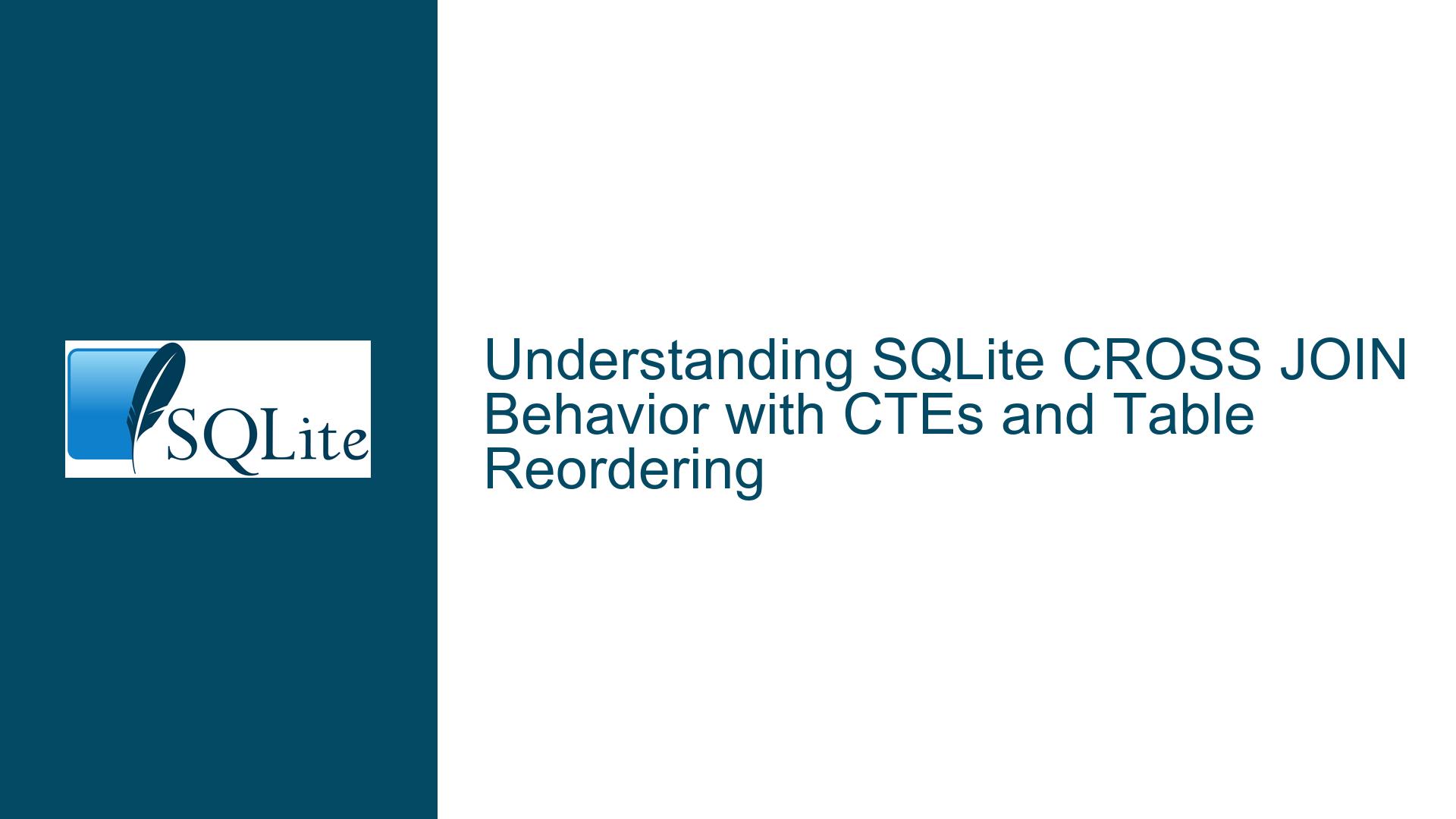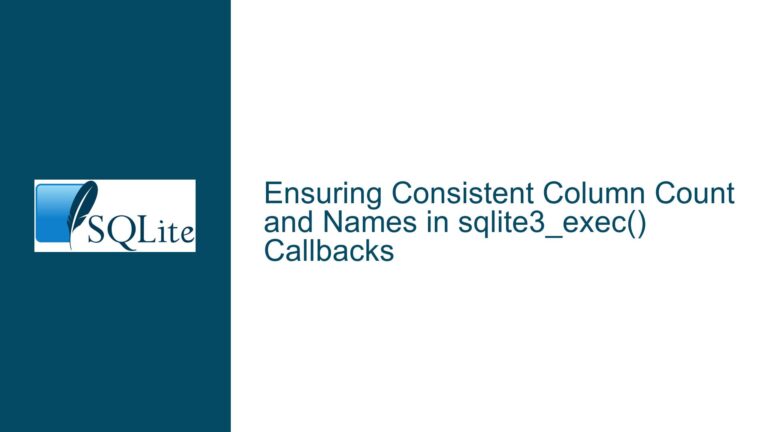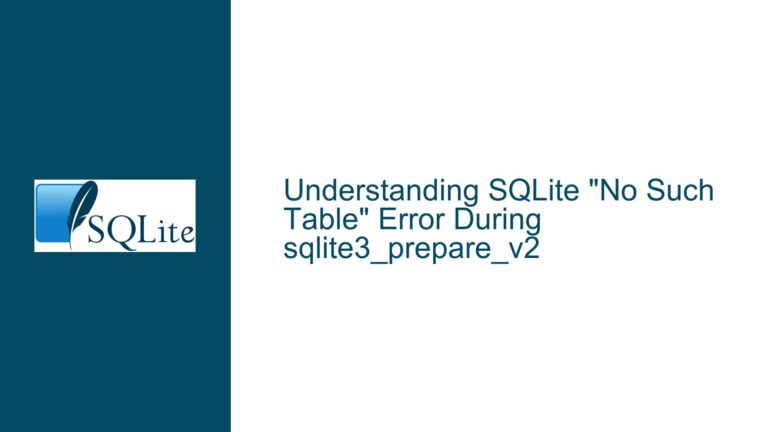SQLite CROSS JOIN Behavior with CTEs and Table Reordering
Issue Overview: CROSS JOIN and CTE Table Reordering in SQLite
In SQLite, the CROSS JOIN operation is often used to enforce a specific order in which tables are joined, preventing the query optimizer from reordering the tables. However, when a Common Table Expression (CTE) is involved as the left-hand side (LHS) of a CROSS JOIN, unexpected behavior can occur. Specifically, the query optimizer may still reorder tables, leading to performance issues or incorrect query results. This issue is particularly relevant when the query involves complex joins and recursive CTEs, as the optimizer’s decisions can significantly impact execution plans.
The core of the problem lies in the interaction between CROSS JOIN semantics and the SQLite query planner. While CROSS JOIN is designed to prevent reordering of its immediate left and right operands, it does not act as a barrier to reordering for tables that are not directly adjacent to the CROSS JOIN. This behavior can be counterintuitive, especially when working with CTEs, as developers may assume that the CROSS JOIN will enforce a strict order across all tables in the query.
Possible Causes: Why CROSS JOIN with CTEs May Not Prevent Reordering
The unexpected reordering of tables in queries involving CROSS JOIN and CTEs can be attributed to several factors:
Query Planner Optimization: SQLite’s query planner is designed to optimize query execution by reordering tables and joins to minimize the cost of the query. While
CROSS JOINrestricts reordering of its immediate operands, the planner may still reorder other tables in the query if it determines that doing so will improve performance. This behavior is particularly evident when the query involves multiple joins and recursive CTEs.CTE Materialization: CTEs are treated as temporary result sets by SQLite. When a CTE is used as the LHS of a
CROSS JOIN, the query planner may choose to materialize the CTE or optimize its execution plan independently of theCROSS JOINconstraint. This can lead to situations where the CTE is not treated as a fixed operand, allowing the planner to reorder other tables in the query.Index Usage and Row Lookups: The query planner’s decision to use indexes or perform row lookups can also influence table reordering. In some cases, the planner may prioritize index-based lookups over direct row lookups, even when the latter would be more efficient. This can result in unexpected execution plans, especially when the query involves complex joins and recursive CTEs.
Misinterpretation of CROSS JOIN Semantics: Developers may misinterpret the documentation, assuming that
CROSS JOINenforces a strict order across all tables in the query. However, the documentation specifies thatCROSS JOINonly prevents reordering of its immediate left and right operands. Tables that are not directly adjacent to theCROSS JOINmay still be reordered by the query planner.
Troubleshooting Steps, Solutions & Fixes: Addressing CROSS JOIN and CTE Reordering Issues
To address the issue of table reordering in queries involving CROSS JOIN and CTEs, consider the following troubleshooting steps and solutions:
Review Query Execution Plans: Use the
EXPLAIN QUERY PLANstatement to analyze the execution plan of your query. This will help you identify whether the query planner is reordering tables in a way that conflicts with your expectations. Pay particular attention to the order in which tables are scanned or searched, as well as the use of indexes.Enforce Table Order with Subqueries: If the query planner is reordering tables in a way that impacts performance or correctness, consider using subqueries to enforce a specific table order. For example, you can rewrite the query to explicitly specify the order in which tables should be joined, ensuring that the CTE is processed before other tables.
Use Temporary Tables: As a workaround, you can materialize the CTE into a temporary table and use this table in the main query. This approach ensures that the CTE is treated as a fixed operand, preventing the query planner from reordering it. For example:
CREATE TEMPORARY TABLE temp_cte AS WITH cte AS ( SELECT ... ) SELECT * FROM cte; SELECT * FROM temp_cte CROSS JOIN ccc outccc1 ON outccc1.c1 = temp_cte.c1 INNER JOIN ccc outccc2 ON outccc2.c2 = outccc1.c2 WHERE temp_cte.c5 = 0;Modify Join Types: If the query involves multiple joins, consider modifying the join types to enforce the desired table order. For example, replacing an
INNER JOINwith aCROSS JOINcan prevent the query planner from reordering the tables. However, this approach should be used with caution, as it may impact the semantics of the query.Optimize Index Usage: Ensure that the query is using the most efficient indexes for table lookups. If the query planner is using an index for a row lookup when a direct row lookup would be more efficient, consider modifying the query or the schema to improve index usage. For example, you can create covering indexes or adjust the query to encourage the planner to use the most efficient access method.
Update SQLite Version: If you are using an older version of SQLite, consider updating to the latest version. Newer versions of SQLite may include improvements to the query planner that address issues with
CROSS JOINand CTE reordering.Consult Documentation and Community: Review the SQLite documentation to ensure that you fully understand the semantics of
CROSS JOINand CTEs. Additionally, consult the SQLite community or forums for insights and best practices related to query optimization and table reordering.
By following these troubleshooting steps and solutions, you can address the issue of table reordering in queries involving CROSS JOIN and CTEs, ensuring that your queries perform as expected and return the correct results.






